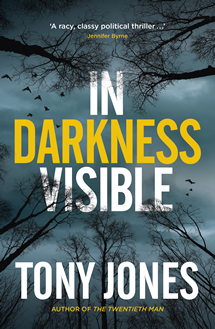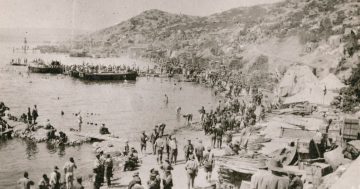Reviewed by Robert Goodman.
By Tony Jones, Allen and Unwin.
 Australian journalist Tony Jones debut novel The Twentieth Man, created a political thriller out of some well known and not so well known parts of Australian history. That story was anchored around the treatment of former Nazi collaborators by the Australian security services and a plot to assassinate the Yugoslavian Prime Minister in the 1970s. That story focussed on cadet journalist Anna Rosen, daughter of a known communist, and her Romeo-and-Juliet style romance with the young Croatian Marin Katich, the son of a former Nazi collaborator. In Darkness Visible is a sequel of sorts to this story, fast forwarding to 2005 and the war crimes trials that followed the Balkan conflict. While it does contain some crime genre elements, this is predominantly historical fiction with a bit of a thriller twist.
Australian journalist Tony Jones debut novel The Twentieth Man, created a political thriller out of some well known and not so well known parts of Australian history. That story was anchored around the treatment of former Nazi collaborators by the Australian security services and a plot to assassinate the Yugoslavian Prime Minister in the 1970s. That story focussed on cadet journalist Anna Rosen, daughter of a known communist, and her Romeo-and-Juliet style romance with the young Croatian Marin Katich, the son of a former Nazi collaborator. In Darkness Visible is a sequel of sorts to this story, fast forwarding to 2005 and the war crimes trials that followed the Balkan conflict. While it does contain some crime genre elements, this is predominantly historical fiction with a bit of a thriller twist.
The book opens with the capture of Marin Katich who has been living under an alias in the years following the end of the Balkan conflict. He is arrested for war crimes and sent to the Hague where he is imprisoned with former Serbian enemies including Slobodan Milosevic, who has an extensive cameo in the story. Anna Rosen, now a famous journalist, is tipped off by an old friend that the prisoner who is still known as Tomislav Maric and believed to be a Croatian general called the Cicada may in fact be Katich, who she had thought killed thirteen years before during the war. She drops everything, and flies to the Netherlands to investigate and once there becomes involves in clearing her former lover’s name. Complicating matters is the fact that Katich is the father of Anna’s daughter Rachel, a fact that she has shared with neither of them.
Jones’ story then ranges back to the 1970s, when Anna and Marin first met and he became a person of interest for the Australian secret service; then to the early 1990s when Katich becomes part of the Croatian forces in the besieged city of Vukovar and then later commands a small army of his own before being betrayed; to the present of 2005 where the world is still coming to terms with the extreme violence and genocidal acts of the Balkan war. Of these the sections in the 1970s, while adding a little colour, do little to progress the story. But the chapters set in the 1990s, which drop readers in the middle of the Balkan war, are visceral and effective. And the reflections on the war crimes trial process, particularly, the lengthy trial of Milosevic, are fascinating.
As with The Twentieth Man, Jones is interested in the legacy of partisan conflict and then impact of nationalism. The fault lines that were exposed in the Second World War which informed the 1970s action of the first book, carry through to the Balkan conflict in the 1990s and continue to persist into the present with a reinterpretation of the actions of the fascist and violent Ustasha. This tragic history which impacts directly on Katich is mired in centuries old racial and religious conflict.
In Darkness Visible is not strictly a thriller but it does draw on thriller elements. The sections set in 1991 when Anna goes as a journalist to the Balkans to hunt for Katich are incredibly tense. And the plot does build to a page turning final act. Anna Rosen, a fifty year old female journalist is an unlikely hero for a thriller, but the type of character we are starting to see more of in Australian fiction (the character of Astrid in Heather Rose’s Bruny is another recent example).
In Darkness Visible takes the story that Jones started in The Twentieth Man in an interesting and topical direction. He once again draws on tragically real events and characters to craft a rich narrative. While the diversions into the distant past feel a little unnecessary, once the pieces are in place this becomes a fascinating and fast-paced narrative.
This and over 400 more reviews can be found on Pile By the Bed.











